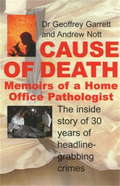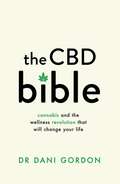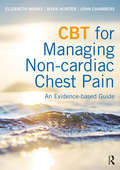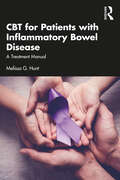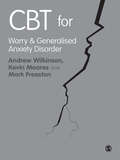- Table View
- List View
Cause of Death: Memoirs of a Home Office Pathologist
by Andrew Nott Dr Geoffrey GarrettDr Geoffrey Garrett was for over 30 years a Home Office pathologist. This is his personal memoir, in conjunction with crime journalist Andrew Nott, of many infamous, unusual and heartbreaking cases and a fascinating history of his professional life, giving a unique insight into a pathologist's work. Beginning with a no-holds-barred account of the basic methodology of a post-mortem examination, the book chronicles many memorable cases, including:The discovery of a preserved body on the Yorkshire moors later identified as the first victim of the Moors MurderersThe murders of three policemen plus the apprehension of a murderer who turned out to be a policeman's sonAn examination of sex crimesThe Moss: a seminal piece on Manchester's 'Bronx' - Dr Garrett reveals life in the ghetto, the drug gangs and how they operate How a man's face, burned beyond recognition, was reconstructed to help solve a murderPlus examples of many other baffling crimes which were resolved on the pathologist's table.
Cause-Related-Marketing-Kampagnen erfolgreich konzipieren: Eine empirische Studie
by Frank Huber Stefanie Regier Maxime RininoDie Autoren untersuchen auf der Basis einer empirischen Studie die Wirkung einer sozialen Werbekampagne auf die Kaufabsicht eines Konsumenten am Beispiel einer Kooperation zwischen einer Pharmazeutikmarke und einer Non-Profit-Organisation. Sie leiten Handlungsempfehlungen für die Marketingpraxis ab, die besonders geeignet sind, die Kaufabsicht durch eine positive Einstellungsbildung zu beeinflussen.
The Causes and Behavioral Consequences of Disasters: Models informed by the global experience 1950-2005
by Sasha Rudenstine Sandro GaleaThe Causes and Behavioral Consequences of Disasters brings a public health perspective to the literature, reflecting the increasing importance of the field in both disaster preparedness and disaster response. Arguing that a disaster is not only the event but its aftermath as well, the authors apply salient local content to the study of scenarios ranging from the Cuzco, Peru, earthquake of 1950 to the Columbine school shooting, the Oklahoma City bombing, and 9/11. These case studies form the basis for models of vulnerabilities to disasters and population behavior following disasters, illustrating how careful pre-event planning and coordinated post-event response strategies can minimize the initial damage and negative aftereffects. The Causes and Behavioral Consequences of Disasters will further professional discussion and understanding among a wide range of professionals and students across public health, mental health, education, health administration and policy, social work, and the social sciences.
Causes and Control of Colorectal Cancer: A Model for Cancer Prevention (Developments in Oncology #78)
by Gabriel A. KuneCauses and Control of Colorectal Cancer: A Model for Cancer Prevention is a ground- breaking monograph which takes a global, multidisciplinary approach to the causes, carcinogenesis and control of colorectal cancer. Over 1000 key studies were analyzed on colorectal cancer cause, carcinogenesis, primary prevention, early detection using modern screening techniques, and surveillance after tumor excision. All major research results are included up to the date of publication. The key chapters include those on morphology, molecular biology and evolution of tumors, etiology chapters on heredity, diet, alcohol, smoking, physical activity, life stress and others, while major chapters in the area of colorectal cancer control are on primary prevention, early detection by screening and surveillance, and post-tumor excision surveillance. Important recommendations on primary prevention, screening and surveillance of colorectal tumors are made in keeping with the most current research data. Causes and Control of Colorectal Cancer: A Model for Cancer Prevention takes colorectal cancer control into the 21st century, and suggests this to be the first cancer in which control will be largely achieved within the next generation, as a result of the unprecedented multidisciplinary research into causation, primary prevention, screening and surveillance over the past 30 years. The book also serves as a model for the control of other common malignancies, particularly cancers of the breast and prostate, the causes and prevention of which are less well understood.
The Caval Catheter
by C. Burri Friedrich W. AhnefeldThe application of the caval catheter in emergency medicine and intensive care has today become routine. Generally, even in severe shock this route of access to the cardiovascular system is available in order to apply life saving volume substitution. It also permits longterm infusions in modern intensive care, particularly continuous administration of high-osmolarity solutions in par enteral nutrition. In both fields it represents one of the most important diagnostic parameters of circulatory disorders, enabl ing the registration of central venous pressure. Its undeniable advantages are counterbalanced by the dangers inherent in all invasive methods. Since sufficient experience and precise sta tistics are now at our disposal, the time has come for a provisional survey. While a few years ago it was considered mandatory to propagate the central venous access in order to advance new therapeutic and diagnostic methods, it is now necessary to recon sider and reformulate indications for its use. In this task it is essential to weigh the expected advantages against the possible complications in each and every case of catheter application. Cri tical scrutiny must include evaluation of techniques, approaches, and finally catheter materials; this paper presents the results of such a survey. The physician is hereby given the opportunity of being completely informed of evaluating the validity of his standard procedures. VIm, April 1977 C. BURRI F. W. AHNEFELD Table of Contents I. Introduction. . . . . . . . . 1 II. Indications for Caval Catheter 3 A. Caval Catheter in Emergency Situations 3 B.
Cave Microbiomes: A Novel Resource For Drug Discovery (Springerbriefs In Microbiology Ser. #1)
by Naowarat CheepthamThis book details recent findings in the field of cave microbiology and builds on fast-paced efforts to exploit an unconventional and underexplored environment for new microorganisms which may provide an untapped source of drugs: microorganisms from caves.
Caveolins and Caveolae: Roles in Signaling and Disease Mechanisms (Advances in Experimental Medicine and Biology #729)
by Jean-François Jasmin Michael P. Lisanti Philippe FrankCaveolae are 50-100 nm flask-shaped invaginations of the plasma membrane that are primarily composed of cholesterol and sphingolipids. Using modern electron microscopy techniques, caveolae can be observed as omega-shaped invaginations of the plasma membrane, fully-invaginated caveolae, grape-like clusters of interconnected caveolae (caveosome), or as transcellular channels as a consequence of the fusion of individual caveolae. The caveolin gene family consists of three distinct members, namely Cav-1, Cav-2 and Cav-3. Cav-1 and Cav-2 proteins are usually co-expressed and particularly abundant in epithelial, endothelial, and smooth muscle cells as well as adipocytes and fibroblasts. On the other hand, the Cav-3 protein appears to be muscle-specific and is therefore only expressed in smooth, skeletal and cardiac muscles. Caveolin proteins form high molecular weight homo- and/or hetero-oligomers and assume an unusual topology with both their N- and C-terminal domains facing the cytoplasm.
Caveolins in Cancer Pathogenesis, Prevention and Therapy (Current Cancer Research)
by Isabelle Mercier, Jean-François Jasmin and Michael P. P. LisantiCaveolins are important structural proteins of Caveolae, small invaginations of the membrane. They have been shown to play an important role in the pathogenesis of multiple cancers. In this volume, we will mainly focus on the importance of Caveolin-1 in breast, prostate, lung, skin, colon, pancreatic and brain cancers with also a mention of the novel role of Caveolin-3 in breast cancer.
Cavernomas of the CNS: Basic Science to Clinical Practice
by Ondřej Bradáč Vladimír BenešThis book presents a complete up-to date description of cavernoma disease together with its known biology, genetics and variable clinical presentation. It facilitates improved decision-making on surgical intervention by presenting different cases, highlighting the particular features of lesions such as anatomical location, eloquences of adjacent brain and type of presentation that are important when making decisions. In addition, the reader is brought up to speed with developments in the neuroimaging and active treatment techniques, especially surgical resection and radiosurgery. Finally, the natural history of the disease is taken into account and compared to the possible benefits of surgical treatment. Cavernomas of the CNS: Basic Science to Clinical Practice provides a comprehensive overview from the fundamentals of this condition, to special patient groups such as children and pregnant women. Therefore, it is an indispensable resource for neurovascular surgeons, neurosurgical residents and neurologists.
The Cavernous Sinus: A Multidisciplinary Approach to Vascular and Tumorous Lesions
by V. V. DolencThe management of vascular and tumorous lesions of the parasellar region still remains one of the most demanding tasks in neurosurgery. It is only a short time ago that the major concepts of the anatomy of the so-called cavernous sinus were described in detail. Surgical interventions in this region are very complex, they are time-consuming and require an extensive back ground of experience in surgery of the cranial base. Pioneer anatomical studies of the parasellar region done by Taptas, and the daring direct operative approach introduced by Parkinson pro moted the development of modern neuroradiological intervention proce dures, which were initiated by Serbinenko and further refined by Debrun, Vifiuela and others. The technique of the detachable balloon catheter stimulated surgeons to proceed with the direct operative approach to lesions of the parasellar region. Today, it is hard to imagine a successful man agement of vascular pathologies of this region without a complementary use of the two techniques.
Cavernous Sinus: Developments and Future Perspectives
by Vinko V. Dolenc Larry RogersProfessor Dolenc edited the first comprehensive and up-to-date text dealing with the cavernous sinus. His book addressed anyone concerned with the diagnosis and treatment of lesions of the skull base. Now, twenty years later, the same author edits a new volume with articles by specialists in the topic presenting the state-of-the-art in this technology.
Cavitation in Biomedicine: Principles and Techniques
by Mingxi Wan Yi Feng Gail Ter HaarThis book offers a systematic introduction to the engineering principles and techniques of cavitation in biomedicine on the basis of its physics and mechanism. Adopting an interdisciplinary approach, it covers areas of interest ranging from physics and engineering to the biological and medical sciences. Individual chapters introduce the fundamentals of cavitation, describe its characterization, control and imaging techniques, and present cavitation-enhanced thermal and mechanical effects and their applications. Intended as both a reference work for graduate students, and as a guide for scientists and engineers who work with cavitation in biomedicine, it provides a broad and solid foundation of knowledge. The aim is to bridge the different disciplines involved, and to promote cross-discipline research, thus encouraging innovations in the scientific research and engineering applications alike. Dr. Mingxi Wan is a professor at Department of Biomedical Engineering, Xi’an Jiao Tong University, Xi’an, Shaanxi, China; Dr. Yi Feng works at Department of Biomedical Engineering, Xi’an Jiao Tong University, Xi’an, Shaanxi, China; Dr. Gail ter Haar is a professor at The Institute of Cancer Research, Sutton, Surry, UK.
Cavitation in Non-Newtonian Fluids: With Biomedical and Bioengineering Applications
by Emil BrujanNon-Newtonian properties on bubble dynamics and cavitation are fundamentally different from those of Newtonian fluids. The most significant effect arises from the dramatic increase in viscosity of polymer solutions in an extensional flow, such as that generated about a spherical bubble during its growth or collapse phase. In addition, many biological fluids, such as blood, synovial fluid, and saliva, have non-Newtonian properties and can display significant viscoelastic behaviour. This monograph elucidates general aspects of bubble dynamics and cavitation in non-Newtonian fluids and applies them to the fields of biomedicine and bioengineering. In addition it presents many examples from the process industries. The field is strongly interdisciplinary and the numerous disciplines involve have and will continue to overlook and reinvent each others’ work. This book helps researchers to think intuitively about the diverse physics of these systems, to attempt to bridge the various communities involved, and to convey the interest, elegance, and variety of physical phenomena that manifest themselves on the micrometer and microsecond scales.
Cawson's Essentials of Oral Pathology and Oral Medicine E-Book
by Roderick A. Cawson Edward W OdellThis is a new edition of a classic textbook of oral pathology and oral medicine for dental students and candidates for postgraduate dentistry exams. Illustrated in colour throughout, the book offers a comprehensive introduction to the pathology of oral disease, its clinical manifestations and the principles of management. A final section deals with the medically compromised patient.Comprehensive coverage of both oral pathology and oral medicine in a single paperback volume Ideal for both undergraduate and post-graduate dentistry exams Lucid writing style provides easy access to essential information Illustrated in high quality throughout, with over 80 new full colour images Ample use of flow charts guide the student thorough the process of differential diagnosis for a range of conditions Classic text explaining the dental relevance of a range of systemic diseases Updated chapters on cancer and premalignancy, including new information on disease management. New section on healing of the normal tooth socket, and pathology of osseointegration and sinusitis. Includes discussion of controversial issues such as prophylaxis for infective endocarditis. Addition of new WHO disease classifications – such as premalignancy. New section on the relationship between the pathology of caries and its treatment. Usability of diagnostic flow charts improved by addition of icons to the relevant sections of text referring the reader to the flow chart. Many sections improved and updated, including cleft lip and palate, maxillary sinusitis and lichenoid reactions to amalgam restorations. New section on implants, implant related lesions and osseointegration.
Cawson's Essentials of Oral Pathology and Oral Medicine E-Book
by Edward W OdellThe new edition of this classic book continues to support a new generation of dental students in their understanding of the essential aspects of oral pathology and oral medicine as they relate to the day-to-day practice of dentistry. Fully updated throughout with the latest diagnostic tests, treatment protocols and international guidelines, the book now comes with Pageburst – an exciting product which provides readers with an eBook – giving them the printed book, plus access to the complete book content electronically. Histology slides within the e-book can be magnified by the reader simulating the use of the microscope and aiding learning by the addition of overlays.
Cawson's Essentials of Oral Pathology and Oral Medicine - E-Book: Cawson's Essentials of Oral Pathology and Oral Medicine - E-Book
by Edward W OdellThe tenth edition of this core textbook will prepare the reader to diagnose and treat many different diseases and disorders that they may not have encountered in person before. The text integrates oral medicine, pathology, and surgical and drug treatment, allowing the reader to apply diagnostic algorithms and develop the key understanding they will need to apply theory to clinical practice. Originally published in 1962, Cawson's Essentials of Oral Pathology and Oral Medicine continues to offer its trademark easy-to-read style, a world-class collection of photographs showing oral conditions, and the latest evidence and guidelines to support safe clinical practice.Thoroughly updated to include new guidelines, oral diseases and treatments including the new WHO Classification of Tumours 2022 terminologyFriendly, accessible writing style provides ready access to essential informationFlow charts to guide the reader thorough the process of differential diagnosis for a range of conditionsEvidenced-based throughout to help facilitate safe clinical practiceSelf-assessment to support understanding and problem solvingSummary charts to aid learning and revisionNew chapters on pathological and diagnostic aspects of cosmetic proceduresNew section on respiratory disease including COVID-19; other new diseases such as MPox includedChapter listing adverse eventsInformation on genetic causes of diseases and tumours, along with novel treatmentsInformation on periodontal diseases completely revised and updated in the light of recent researchNew and extra images included throughout
The CBD Bible: Cannabis and the Wellness Revolution That Will Change Your Life
by Dr Dani GordonWhat's the best natural product to help with my anxiety?Could cannabis cure my insomnia?Can you overdose on CBD oil?Will CBD gummies get me high?Cannabidiol, more commonly known as CBD, has become the hot new wellness ingredient, appearing in everything from oils to edibles and skincare products. Yet this brave new world of CBD and medical cannabis is full of pseudoscience, misinformation and confusion. Now internationally-recognised expert Dr Dani Gordon tells you everything you need to know in order to experience the benefits of this wellness revolution.As a medical doctor with years of clinical experience in prescribing cannabis and CBD in many forms, Dr Gordon is ideally placed to take us on an entertaining and enlightening journey about the cannabis plant and its benefits. She cuts through the hype, dispels the myths, and introduces us to the fascinating endocannabinoid system in our own body.The CBD Bible offers the most up to date evidence on the use of CBD for anxiety, depression, insomnia, joint pain and many other health concerns. Dr Gordon's reassuring and science-based advice will give you the confidence and the information to heal yourself with the power of plants.Dr Dani Gordon is a double board certified medical doctor, integrative medicine physician and world-leadingexpert in CBD and cannabis medicine. She has spoken on cannabis medicine at the UN and to government bodies.
CBD For Dummies
by Blair Lauren BrownAn informative, easy-to-understand resource that unveils the mysteries of CBD CBD has emerged as a popular health product, but what's all the fuss about? CBD For Dummies reveals the reasons for the surge in interest about cannabidiol (CBD) and explains how to buy and use this remarkable product safely and responsibly. In an accessible, no-nonsense manner, author Blair Lauren Brown lays out the facts about CBD and outlines the many health conditions that may be helped by using CBD oil. This book covers topics that people new to CBD have questions about. Highlights include: What CBD oil is and how it works in the body How to buy CBD from a reputable source and understanding a product's potency Knowing what conditions can be eased with CBD, including muscle pain, inflammation, autoimmune conditions, eating disorders, mental health disorders, and neurological conditions Preparing your own CBD edibles Perfect for anyone interested in understanding the therapeutic potential of CBD, CBD For Dummies introduces you to everything you need to know about this cool compound.
CBD For Dummies
by Blair Lauren BrownAn informative, easy-to-understand resource that unveils the mysteries of CBD CBD has emerged as a popular health product, but what's all the fuss about? CBD For Dummies reveals the reasons for the surge in interest about cannabidiol (CBD) and explains how to buy and use this remarkable product safely and responsibly. In an accessible, no-nonsense manner, author Blair Lauren Brown lays out the facts about CBD and outlines the many health conditions that may be helped by using CBD oil. This book covers topics that people new to CBD have questions about. Highlights include: What CBD oil is and how it works in the body How to buy CBD from a reputable source and understanding a product's potency Knowing what conditions can be eased with CBD, including muscle pain, inflammation, autoimmune conditions, eating disorders, mental health disorders, and neurological conditions Preparing your own CBD edibles Perfect for anyone interested in understanding the therapeutic potential of CBD, CBD For Dummies introduces you to everything you need to know about this cool compound.
CBT for Managing Non-cardiac Chest Pain: An Evidence-based Guide
by Elizabeth Marks Myra Hunter John ChambersCBT for Managing Non-cardiac Chest Pain is an evidence-based guide and workbook for clinicians working with people with non-cardiac chest pain (NCCP). NCCP affects around 25–30% of people in the UK, USA, and Europe and is associated with high levels of health care use and compromised quality of life. This is the first book to describe a treatment programme to fill the gap in care for patients. The authors have developed and researched a novel approach that demonstrates how physiological, cognitive, behavioural and social factors all contribute to the negative experience of chest pain. With the help of exercises and downloadable handouts for the patient, the book aims to provide the necessary information and clinical skills and approaches for clinicians to use in health care settings. CBT for Managing Non-cardiac Chest Pain will appeal to anyone involved in the care of patients with NCCP, including nurses; general practitioners; cardiologists; acute medical physicians and psychologists.
CBT for Managing Non-cardiac Chest Pain: An Evidence-based Guide
by Elizabeth Marks Myra Hunter John ChambersCBT for Managing Non-cardiac Chest Pain is an evidence-based guide and workbook for clinicians working with people with non-cardiac chest pain (NCCP). NCCP affects around 25–30% of people in the UK, USA, and Europe and is associated with high levels of health care use and compromised quality of life. This is the first book to describe a treatment programme to fill the gap in care for patients. The authors have developed and researched a novel approach that demonstrates how physiological, cognitive, behavioural and social factors all contribute to the negative experience of chest pain. With the help of exercises and downloadable handouts for the patient, the book aims to provide the necessary information and clinical skills and approaches for clinicians to use in health care settings. CBT for Managing Non-cardiac Chest Pain will appeal to anyone involved in the care of patients with NCCP, including nurses; general practitioners; cardiologists; acute medical physicians and psychologists.
CBT for Patients with Inflammatory Bowel Disease: A Treatment Manual
by Melissa G. HuntThis treatment manual provides cognitive behavioral therapists with the inflammatory bowel disease (IBD) specific knowledge and content they need to work with this patient population.Understanding the very real challenges of living with an IBD, and what sorts of catastrophic thoughts and maladaptive avoidance behaviors patients might have, can make therapy more focused, efficient, and effective. This manual encourages flexible, modular deployment of numerous empirically supported principles, techniques, and interventions, and includes five treatment protocols with hypothetical patients.This book is essential for therapists with training in cognitive behavioral therapy who are interested in expanding their practice competence to work with patients with GI disorders, including inflammatory bowel disease.
CBT for Patients with Inflammatory Bowel Disease: A Treatment Manual
by Melissa G. HuntThis treatment manual provides cognitive behavioral therapists with the inflammatory bowel disease (IBD) specific knowledge and content they need to work with this patient population.Understanding the very real challenges of living with an IBD, and what sorts of catastrophic thoughts and maladaptive avoidance behaviors patients might have, can make therapy more focused, efficient, and effective. This manual encourages flexible, modular deployment of numerous empirically supported principles, techniques, and interventions, and includes five treatment protocols with hypothetical patients.This book is essential for therapists with training in cognitive behavioral therapy who are interested in expanding their practice competence to work with patients with GI disorders, including inflammatory bowel disease.
CBT for Worry and Generalised Anxiety Disorder
by Andrew Wilkinson Kevin Meares Mark FreestonThis practical introduction helps trainees use cognitive behavioural therapy to assess and treat generalised anxiety disorder (GAD), one of the most commonly presented client issues. Taking the reader step-by-step through each stage of CBT with anxiety and worry, the authors illustrate the whole range of different treatment techniques whilst keeping the book accessible and concise. Tailored to current High and Low Intensity (IAPT) training, it covers self-help literature as well as traditional one-to-one therapy. The book: - contains illustrative case material, balancing an evidence-based approach with awareness of the realities of today's practice - alerts trainees to the potential complicating factors and the co-existence of other anxiety or mood disorders alongside GAD - addresses cross-cutting professional themes, such as working with morbidity and the pressures of working within NHS settings. Bridging the gap between theory and practice, this book is essential reading for all CBT trainees on IAPT programmes, as well as trainees on postgraduate counselling, psychotherapy and clinical psychology courses. Qualified therapists who require an update in this area will also find this a useful resource.
